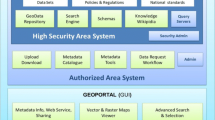Abstract
This study discusses a possible approach for an inter-organizational relationship between Participatory Map Organization (PMO) and the National Mapping Agency (NMA) in the context of collaboration and spatial data utilization under the influence of the Geospatial Information Act in Indonesia. The potential of PMO’s volunteered geographic information to accelerate and enrich authoritative spatial data production is experiencing issues as the Act has stated that NMA has become the only organization to govern almost all spatial-related activities within the Indonesian region. Interviews have been conducted to address the existing conditions and also to foresee the ideal relationship between PMO and NMA to enable spatial data enrichment that benefits both parties. The results of this study can be helpful as an insight to build and maintain an inter-organizational relationship under the conditions that might similarly exist.
Zusammenfassung
Diese Studie behandelt einen möglichen Ansatz für die organisationsübergreifende Beziehung zwischen einer Organisation für partizipative Kartierung (Participatory Map Organization - PMO) und dem Bundesamt für Kartierung (National Mapping Agency-NMA) im Rahmen der Zusammenarbeit und der Nutzung der räumlichen Daten unter dem Einfluss vom Gesetz zur georäumlicher Information (Geospatial Information Act) in Indonesien. Das Potenzial von PMOs freiwillig produzierter geografischer Informationen zur Beschleunigung und Bereicherung der amtlichen Produktion der räumlichen Daten trifft auf Probleme. Dies hangt damit zusammen, dass das Gesetz festgelegt hat dass die NMA die einzige Organisation geworden ist, die fast alle raumbezogenen Aktivitäten innerhalb der indonesischen Region steuert. Interviews wurden durchgeführt um die bestehenden Bedingungen zu thematisieren und auch, um die ideale Beziehung zwischen PMO und NMA vorauszusehen, welche die Bereicherung der räumlichen Daten ermöglichen soll, von denen beide Seiten profitieren. Die Ergebnisse dieser Studie können dabei helfen, ein Verständnis zu schaffen, wie eine interorganisatorische Beziehung aufgebaut und aufrechterhalten werden kann und das unter Bedingungen, die ahnlich existieren können.
Similar content being viewed by others
References
A. A. S. J. and Pramono, A. H. (2009). Menuju demo-kratisasi pemetaan: refleksigerakan pemetaan partisipatifdi Indonesia, Jaringan Kerja Pemetaan Partisipatif. Available at: https://books.google.de/books?id=HpRXQwAACAAJ.
Adams, D. (2013). Volunteered Geographic Information: Potential Implications for Participatory Planning. Planning Practice and Research, 28(4), pp.464–469. Available at: http://www.tandfonline.com/doi/abs/10.1080/02697459.2012.725549⊀ttp://wwwtandfon line.com/doi/pdf/10.1080/02697459.2012.725549.
Adams, D. and Hess, M. (2001). Community in Public Policy: Fad or Foundation?
Anheier, H. K. (2005). Nonprofit Organizations: Theory Management Policy, Available at: http://books.google.com/books?id=s_uzg-KoVylC&pgis= 1.
Anon, BIG Bersama Menata Indonesia Yang Lebih Baik. I Available at: http://www.bakosurtanal.go.id/beritasurta/show/big-selenggarakan-soft-launching-aplikasipemetaa-npartisipatif [Accessed March 23, 2015].
Atok, K., (2008). Gerakan Pemetaan Partisipatif di Indonesia. Available at: http://kristianusatok.blogspot.de/2008/03/gerakan-pemetaan-partisipatif-di.html [Accessed March 10,2015].
Begin, D. (2012). Towards Integrating VGI and National Mapping Agency Operations-A Canadian Case Study. In The Role of Volunteer Geographic Information in Advancing Science: Quality and Credibility Workshop. Gl-Science Conference.
Brinkerhoff, J. M. (2002). Government - Nonprofit Partnership: a Defining Framework., 30, pp. 19–30.
Coleman, D. J. (2013). Potential Contributions and Challenges of VGI for Conventional Topographic Base-Mapping Programs. In Crowdsourcing Geographic Knowledge: Volunteered Geographic Information (VGI) in Theory and Practice, pp. 245–263.
Corbett, J. (2009). Good practices in participatory mapping: a review prepared for the International Fund for Agricultural Development (IFAD).
Cropper, S., (2008). The Oxford handbook of inter-organizational relations, Oxford Handbooks Online.
Daft, R. (2012). Organization theory and design, Cengage learning.
Degrossi, L. and Albuquerque, J. de (2014). Flood Citizen Observatory: a crowdsourcing-based approach for flood risk management in Brazil, agora.icmc.usp.br. Available at: http://www.agora.icmc.usp.br/site/files/ papers/degrossi-seke2014.pdf.
Denhardt, R. B. & Grubbs, J. W., (2003). Public Administration: An Action Orientation, Wadsworth/Thomson Learning. Available at: http://books.google.de/books?id=VZ3yGkXgEIEC.
Georgiadou, Y.; Budhathoki, N. R. and Nedovic’-Budic, Z. (2011). An Exploration of SDI and Volunteered Geographic Information in Africa. In Z. Nedovic-Budic, J. Crompvoets, & Y. Georgiadou, eds. Spatial Data Infrastructures in Context: North and South. CRC Press, pp. 203–218.
Horita, F. E. A. et al. (2013). The use of Volunteered Geographic Information and Crowdsourcing in Disaster Management: a Systematic Literature Review. In Proceedings of the Nineteenth Americas Conference on Information Systems, Chicago Illinois, August 15–17, 2013. AIS, pp. 1–10.
Huczynski, A. and Buchanan, D. A. (2001). Organizational Behaviour: An Introductory Text, Financial Times/ Prentice Hall. Available at: http://books.google.de/books?id=uBB5SQAACAAJ.
Keast, R. and Waterhouse, J. (2006). Participatory evaluation: a missing component in the sustainable social change equation for public services. Strategic Change, 15, pp. 23–35.
Mandell, M. and Keast, R. L. (2008). Voluntary and community sector partnerships: current inter-organizational relations and future challenges. The Oxford handbook of inter-organizational relations, pp. 175–202.
Nirarta, S.T. (2013). Indonesia ONE MAP: Assuring Better Delivery of National Development Goals. In: Monetising Geospatial Value and Practices for National Development Goals, geospatial world forum. Available at: http://www.geospatialworldforum.org/2013/presenta tion/Nirata Samdhi.pdf.
Oliver, C. (1990). Determinants of Interorganizational Relationships: Integration and Future Directions. Academy of Management Review, 15(2), pp. 241–265.
Republik Indonesia, (2013). Peraturan Pemerintah Tentang Ketelitian Peta Rencana Tata Ruang.
Republik Indonesia, (2011a). Perpres Nomor 94 Tahun 2011 Mengenai Badan Informasi Geospasial, Indonesia. Available at: http://www.bakosurtanal.go.id/assets/download/UUJG/PERPRES NOMOR 94 TAHUN2011.pdf.
Republik Indonesia, (2011b). Undang-undang Republik Indonesia Nomor 4 Tahun 2011 Tentang Informasi Geospasial, Indonesia. Available at: http://www.bakosurtanal.go.id/assets/download/UU_IG/UU NO 4THN 2011 TENTANG INFORMASI GEOSPASIAL.pdf.
Schein, E. H. (1988). Organizational Psychology, Prentice-Hall. Available at: https://books.google.de/books?id=rwBiQgAACAAJ.
Sui, D.; Elwood, S. and Goodchild, M. (2012). Crowdsourcing geographic knowledge, Available at: http://www.springerlink.com/cotent/978-94-007-4586-5/contents/.
Zook, M. et al. (2010). Volunteered geographic information and crowdsourcing disaster relief: a case study of the Haitian earthquake. World Medical & Health Policy, 2, pp.7–33. Available at: http://doi.wiley.com/10.2202/1948-4682.1069⊀ttp.7/onlinelibrary. wiley.com/doi/10.2202/1948-4682.1069/abstract.
Author information
Authors and Affiliations
Corresponding author
Additional information
Harry Ferdiansyah is a staff of Badan Informasi Geospasial (BIG - National Mapping Agency of Indonesia) and PhD student at Otto-Friedrich-Universität Bamberg. He holds M. Sc. in Geoinformatics with research interest in webmapping, spatial data processing and volunteered geographic information.
Rights and permissions
About this article
Cite this article
Ferdiansyah, H. Finding a New Approach for Participatory Mapping Organization and National Mapping Agency Relation in Indonesia. j. Cartogr. Geogr. inf. 65, 230–237 (2015). https://doi.org/10.1007/BF03545145
Received:
Revised:
Published:
Issue Date:
DOI: https://doi.org/10.1007/BF03545145
Keywords
- inter-organizational relationship
- collaboration mapping
- Geospatial Information Act
- Participatory Mapping Organization
- National Mapping Agency




